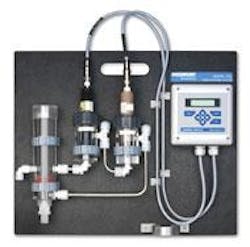Reagent-Free Analysis Systems Help Monitor Chlorine
Rosemount Analytical offers instruments for monitoring free chlorine or monochloramine in drinking water, without the need for reagents.
Typical chlorine analyzers use reagents to convert chlorine into a form the instrument can measure. Typically, a reagent bottle lasts between one and two months, so chemical costs are a constant drain on plant budgets. A reagent-based analyzer also requires a sample conditioning system: a pump to inject reagents, tubing to carry reagents and sample, and a mixing device. Tubing needs periodic replacing and mixing chambers need cleaning, so a reagent-based system requires maintenance beyond simply replacing chemicals.
Rosemount avoids the continuing expense and inconvenience of reagent-based analyzers with its new reagent-free analysis systems: the Model FCL for free chlorine and the Model MCL for monochloramine.
The Model FCL consists of an electronics package, a flow system and two sensors. One sensor measures chlorine and the other measures pH. The pH measurement is needed because the chlorine sensor responds to both free chlorine and pH. As pH increases, the chlorine signal decreases, even though the free chlorine concentration remains constant. A pH correction algorithm in the analyzer compensates the chlorine signal for pH changes. The compensation algorithm is valid to pH 9.5. Because most municipal water sources have pH below 9.5, there are very few utilities that cannot use the FCL.
Continuous pH correction is not always necessary. If the pH varies less than 0.2, no correction is needed. A more simple version of the FCL, having only a chlorine sensor, can be used. The linear range of the FCL is 0-6 ppm but with proper calibration, can be used as high as 20 ppm.
The Model MCL for monochloramine looks like the single sensor version of the FCL. The monochloramine sensor response is practically independent of pH, so a separate pH sensor is not needed. The linear range of the MCL is 0-15 ppm.
Maintaining the FCL and MCL is simple. The chlorine sensors contain a fill solution and a membrane, both of which need replacing about every three months. No special tools are required and the job can be completed in less than five minutes. The pH sensor in the FCL requires no maintenance other than occasional cleaning. The flow controller has no moving parts — constant head provided by an overflow tube controls flow.
In addition to being reagent-free, the FCL and MCL have other advantages. Both systems are complete, so ordering and installation is easy. Everything — sensor(s), analyzer and constant head flow controller — is mounted on a back plate. The user simply mounts the unit on a wall, brings in sample and power, and provides a drain. Sensor cables are pre-wired to
the analyzer and Variopol quick-connect fittings attach the sensor to the cable. Required sample flow is only three gallons per hour.
The FCL and MCL use the popular Rosemount Analytical Model 1055 Solu Comp II analyzers. The Model 1055 has a bright, back-lit two-line display, two completely programmable outputs and three fully programmable alarm relays. An intuitive menu structure and plain language prompts simplify programming and calibrating the FCL and MCL.

